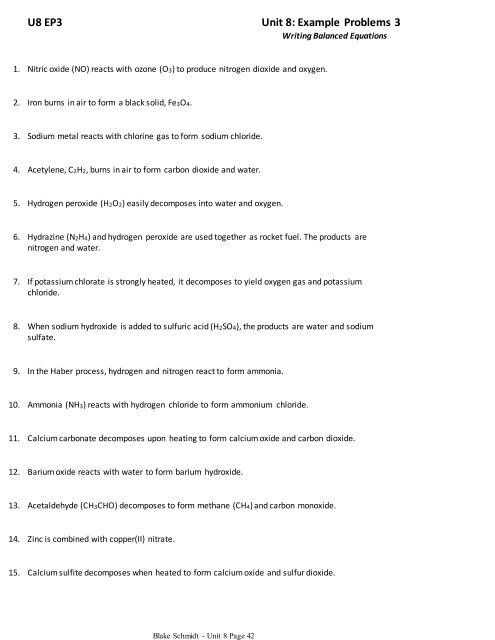Chemistry Manual 2012-2013 - Edison State College
Chemistry Manual 2012-2013 - Edison State College
Chemistry Manual 2012-2013 - Edison State College
Create successful ePaper yourself
Turn your PDF publications into a flip-book with our unique Google optimized e-Paper software.
Blake Schmidt - Unit 8 Page 42<br />
U8 EP3<br />
Unit 8: Example Problems 3<br />
Writing Balanced Equations<br />
1.<br />
Nitric oxide (NO) reacts with ozone (O3) to produce nitrogen dioxide and oxygen.<br />
2.<br />
Iron burns in air to form a black solid, Fe3O4.<br />
3.<br />
Sodium metal reacts with chlorine gas to form sodium chloride.<br />
4.<br />
Acetylene, C2H2, burns in air to form carbon dioxide and water.<br />
5.<br />
Hydrogen peroxide (H2O2) easily decomposes into water and oxygen.<br />
6.<br />
Hydrazine (N2H4) and hydrogen peroxide are used together as rocket fuel. The products are<br />
nitrogen and water.<br />
7.<br />
If potassium chlorate is strongly heated, it decomposes to yield oxygen gas and potassium<br />
chloride.<br />
8.<br />
When sodium hydroxide is added to sulfuric acid (H2SO4), the products are water and sodium<br />
sulfate.<br />
9.<br />
In the Haber process, hydrogen and nitrogen react to form ammonia.<br />
10.<br />
Ammonia (NH3) reacts with hydrogen chloride to form ammonium chloride.<br />
11.<br />
Calcium carbonate decomposes upon heating to form calcium oxide and carbon dioxide.<br />
12.<br />
Barium oxide reacts with water to form barium hydroxide.<br />
13.<br />
Acetaldehyde (CH3CHO) decomposes to form methane (CH4) and carbon monoxide.<br />
14.<br />
Zinc is combined with copper(II) nitrate.<br />
15.<br />
Calcium sulfite decomposes when heated to form calcium oxide and sulfur dioxide.



